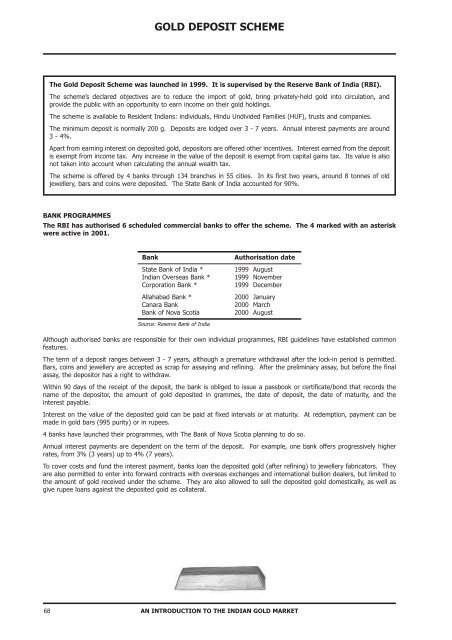Indian Gold Book:Indian Gold Book - Gold Bars Worldwide
Indian Gold Book:Indian Gold Book - Gold Bars Worldwide
Indian Gold Book:Indian Gold Book - Gold Bars Worldwide
Create successful ePaper yourself
Turn your PDF publications into a flip-book with our unique Google optimized e-Paper software.
GOLD DEPOSIT SCHEME<br />
The <strong>Gold</strong> Deposit Scheme was launched in 1999. It is supervised by the Reserve Bank of India (RBI).<br />
The scheme’s declared objectives are to reduce the import of gold, bring privately-held gold into circulation, and<br />
provide the public with an opportunity to earn income on their gold holdings.<br />
The scheme is available to Resident <strong>Indian</strong>s: individuals, Hindu Undivided Families (HUF), trusts and companies.<br />
The minimum deposit is normally 200 g. Deposits are lodged over 3 - 7 years. Annual interest payments are around<br />
3 - 4%.<br />
Apart from earning interest on deposited gold, depositors are offered other incentives. Interest earned from the deposit<br />
is exempt from income tax. Any increase in the value of the deposit is exempt from capital gains tax. Its value is also<br />
not taken into account when calculating the annual wealth tax.<br />
The scheme is offered by 4 banks through 134 branches in 55 cities. In its first two years, around 8 tonnes of old<br />
jewellery, bars and coins were deposited. The State Bank of India accounted for 90%.<br />
BANK PROGRAMMES<br />
The RBI has authorised 6 scheduled commercial banks to offer the scheme. The 4 marked with an asterisk<br />
were active in 2001.<br />
Bank Authorisation date<br />
State Bank of India * 1999 August<br />
<strong>Indian</strong> Overseas Bank * 1999 November<br />
Corporation Bank * 1999 December<br />
Allahabad Bank * 2000 January<br />
Canara Bank 2000 March<br />
Bank of Nova Scotia 2000 August<br />
Source: Reserve Bank of India<br />
Although authorised banks are responsible for their own individual programmes, RBI guidelines have established common<br />
features.<br />
The term of a deposit ranges between 3 - 7 years, although a premature withdrawal after the lock-in period is permitted.<br />
<strong>Bars</strong>, coins and jewellery are accepted as scrap for assaying and refining. After the preliminary assay, but before the final<br />
assay, the depositor has a right to withdraw.<br />
Within 90 days of the receipt of the deposit, the bank is obliged to issue a passbook or certificate/bond that records the<br />
name of the depositor, the amount of gold deposited in grammes, the date of deposit, the date of maturity, and the<br />
interest payable.<br />
Interest on the value of the deposited gold can be paid at fixed intervals or at maturity. At redemption, payment can be<br />
made in gold bars (995 purity) or in rupees.<br />
4 banks have launched their programmes, with The Bank of Nova Scotia planning to do so.<br />
Annual interest payments are dependent on the term of the deposit. For example, one bank offers progressively higher<br />
rates, from 3% (3 years) up to 4% (7 years).<br />
To cover costs and fund the interest payment, banks loan the deposited gold (after refining) to jewellery fabricators. They<br />
are also permitted to enter into forward contracts with overseas exchanges and international bullion dealers, but limited to<br />
the amount of gold received under the scheme. They are also allowed to sell the deposited gold domestically, as well as<br />
give rupee loans against the deposited gold as collateral.<br />
68<br />
AN INTRODUCTION TO THE INDIAN GOLD MARKET

















